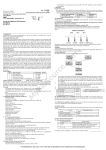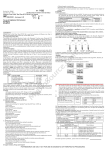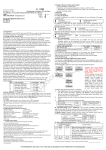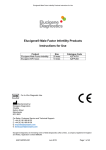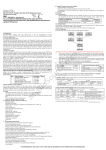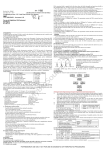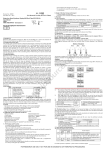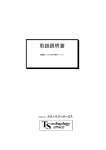Download MBS598276 - MyBioSource
Transcript
For use with LightCycler1.0/2.0 Instrument To generate a standard curve on the real-time system, all four dilution standards should be used and defined as standard with specification of the corresponding concentrations. Attention: A. Mix thoroughly before next transfer. B. The positive control (1×107copies/ml) contains high concentration of the target DNA. Therefore, be careful during the dilution in order to avoid contamination. 9.3 RT-PCR Protocol The Master Mix volume for each reaction should be pipetted as follows: So ur 1. Intended Use Leukemia SIL-TAL1 Fusion Gene real time RT-PCR Kit is used for the detection of Leukemia SIL-TAL1 Fusion Gene in leukocyte by using real time PCR systems. 2. Principle of Real-Time PCR The principle of the real-time detection is based on the fluorogenic 5’nuclease assay. During the PCR reaction, the DNA polymerase cleaves the probe at the 5’ end and separates the reporter dye from the quencher dye only when the probe hybridizes to the target DNA. This cleavage results in the fluorescent signal generated by the cleaved reporter dye, which is monitored real-time by the PCR detection system. The PCR cycle at which an increase in the fluorescence signal is detected initially is proportional to the amount of the specific PCR product. Monitoring the fluorescence intensities in real-time allows the detection of the accumulating product without having to re-open the reaction tube after the amplification. 3. Product Description The microdeletion on 1p32 is the most frequent chromosome aberration found in childhood T-ALL. The microdeletion involves the TAL1 gene (T-cell acute leukemia 1 gene) and the SIL gene (SCL interrupting locus), which is located approximately 90 kb upstream. SIL-TAL1 transcripts are exclusively found in T-ALL, in which they are present in 5-25% of the patients. The SIL-TAL1 fusion gene transcripts seem to be more frequent in children compared to adults. Leukemia SIL-TAL1 fusion gene real time RT-PCR kit contains a specific ready-to-use system for the detection of the Leukemia SIL-TAL1 fusion gene using RT-PCR (Reverse Transcription Polymerase Chain Reaction) in the real-time PCR system. The reaction is done in one step real time RT-PCR. The first step is a reverse transcription (RT), during which the Leukemia SIL-TAL1 fusion gene is transcribed into cDNA. Afterwards, a thermostable DNA polymerase is used to amplify the specific gene fragments by means of PCR (polymerase chain reaction). Fluorescence is emitted and measured by the real time systems optical unit during the PCR. The detection of amplified SIL-TAL1 fragment is performed in fluorimeter channel 530nm with the fluorescent quencher BHQ1. An external positive control (1×107copies/ml) supplied, allows the determination of the gene load. For further information, please refer to section 9.2 Quantitation. 4. Kit Contents Ref. Type of reagent Presentation 25rxns 1 SIL-TAL1 Super Mix 1 vial, 380l 2 RT-PCR Enzyme Mix 1 vial, 28l 3 Molecular Grade Water 1 vial, 400μl 4 SIL-TAL1 Positive Control(1×107copies/ml) 1 vial, 30μl om MBS598276 - Instrument I, II .c User Manual ce Revision No.: ZJ0002 Issue Date:Jul 1st, 2015 (For Research Use Only In USA & China) Leukemia SIL-TAL1 Fusion Gene Real Time RT-PCR Kit • Transportation of clinical specimens must comply with local regulations for the transport of etiologic agents 9. Procedure 9.1 RNA-Extraction RNA extraction kits are available from various manufacturers. You may use your own extraction systems or the commercial kit based on the yield. For the RNA extraction, please comply with the manufacturer’s instructions. The recommended extraction kit is as follows: Nucleic Acid Isolation Kit Cat. Number Manufacturer RNA Isolation Kit ME-0010/ME-0012 ZJ Biotech Qiagen RNeasy Mini Kit 74106 QIAGEN 9.2 Quantitation The kit can be used for quantitative or qualitative real-time RT-PCR. A positive control defined as 1×107copies/ml is supplied in the kit. For performance of quantitative real-time PCR, Standard dilutions must prepare first as follows. Molecular Grade Water is used for dilution. Dilution is not needed for performance of qualitative real-time PCR. Take positive control (1×107copies/ml) as the starting high standard in the first tube. Respectively pipette 36ul of Molecular Grade Water into next three tubes. Do three dilutions as the following figures: M yB io Analysis sensitivity: 1×103copies/ml; LOQ:2×103~1×108copies/ml Note: Analysis sensitivity depends on the sample volume, elution volume, nucleic acid extraction methods and other factors .If you use the RNA extraction kits recommended, the analysis sensitivity is the same as it declares. However, when the sample volume is dozens or even hundreds of times greater than elution volume by some concentrating method, it can be much higher. 5. Storage • All reagents should be stored at -20°C. Storage at +4°C is not recommended. • All reagents can be used until the expiration date indicated on the kit label. • Repeated thawing and freezing (> 3x) should be avoided, as this may reduce the sensitivity of the assay. • Cool all reagents during the working steps. • Super Mix should be stored in the dark. 6. Additionally Required Materials and Devices • Biological cabinet • Real time PCR system • Desktop microcentrifuge for “eppendorf” type tubes (RCF max. 16,000 x g) • Vortex mixer • RNA extraction kit • Real time PCR reaction tubes/plates • Cryo-container • Pipets (0.5 μl – 1000 μl) • Sterile filter tips for micro pipets • Sterile microtubes • Disposable gloves, powderless • Biohazard waste container • Refrigerator and freezer • Tube racks 7. Warnings and Precaution • Carefully read this instruction before starting the procedure. • For in vitro diagnostic use only. • This assay needs to be carried out by skilled personnel. • Clinical samples should be regarded as potentially infectious materials and should be prepared in a laminar flow hood. • This assay needs to be run according to Good Laboratory Practice. • Do not use the kit after its expiration date. • Avoid repeated thawing and freezing of the reagents, this may reduce the sensitivity of the test. • Once the reagents have been thawed, vortex and centrifuge briefly the tubes before use. • Prepare quickly the Reaction mix on ice or in the cooling block. • Set up two separate working areas: 1) Isolation of the RNA/ DNA and 2) Amplification/ detection of amplification products. • Pipets, vials and other working materials should not circulate among working units. • Use always sterile pipette tips with filters. • Wear separate coats and gloves in each area. • Do not pipette by mouth. Do not eat, drink, smoke in laboratory. • Avoid aerosols. 8. Sample Collection, Storage and transport • Collected samples in sterile tubes. • Specimens can be extracted immediately or frozen at -20°C to -80°C. 1) The volumes of Super Mix and Enzyme Mix per reaction multiply with the number of samples, which includes the number of controls and sample prepared. Molecular Grade Water is used as the negative control. For reasons of unprecise pipetting, always add an extra virtual sample. Mix completely then spin down briefly in a centrifuge. Mix completely then spin down briefly in a centrifuge. 2) Pipet 15μl Master Mix with micropipets of sterile filter tips to each of the real time PCR reaction plate/tubes. Separately add 5μl RNA sample, positive and negative controls to different plate/tubes. Immediately close the plate/tubes to avoid contamination. 3) Spin down briefly in order to collect the Master Mix in the bottom of the reaction tubes. 4) Perform the following protocol in the instrument: 45°C for 20min 1cycle Selection of fluorescence channels 95°C for 5min 1cycle 530nm Target Nucleic Acid 95°C for 5sec, 58°C for 20 sec, 72°C for 35 sec 45cycles ( Fluorescence measured at 58°C) 10. Threshold setting: Choose Arithmetic as back ground and none as Noise Band method, then adjust the Noise band just above the maximum level of molecular grade water, and adjust the threshold just under the minimum of the positive control. 11. Calibration for quantitative detection: Input each concentration of standard controls at the end of run, and a standard curve will be automatically formed. 12. Quality control: Negative control, positive control, QS and must be performed correctly, otherwise the sample results is invalid. Channel Crossing point value Control 530nm Molecular Grade Water Blank Positive Control(qualitative assay) ≤35 QS(quantitative detection) Correlation coefficient of QS curve≤-0.98 13. Data Analysis and Interpretation The following results are possible: Crossing point value Result Analysis 1 Blank Below the detection limit or negative 2 ≤43 Positive; the sample contains SIL-TAL1 fusion gene transcripts; and the software displays the quantitative value 3 Re-test; If it is still 43~45, report as 1# 43~45 For further questions or problems,please contact our technical support FOR RESEARCH USE ONLY. NOT FOR USE IN DIAGNOSTIC OR THERAPEUTIC PROCEDURES. For use with ABI Prism®7000/7300/7500/7900/Step One Plus; iCycler iQ™4/iQ™5; Smart Cycler II;Bio-Rad CFX 96;Rotor Gene™6000; Mx3000P/3005P;MJ-Option2/Chromo4; LightCycler®480 Instrument To generate a standard curve on the real-time system, all four dilution standards should be used and defined as standard with specification of the corresponding concentrations. Attention: A. Mix thoroughly before next transfer. B. The positive control 7 (1×10 copies/ml) contains high concentration of the target DNA. Therefore, be careful during the dilution in order to avoid contamination. 9.3 RT-PCR Protocol The Master Mix volume for each reaction should be pipetted as follows: So ur 1. Intended Use Leukemia SIL-TAL1 Fusion Gene real time RT-PCR Kit is used for the detection of Leukemia SIL-TAL1 Fusion Gene in leukocyte by using real time PCR systems. 2. Principle of Real-Time PCR The principle of the real-time detection is based on the fluorogenic 5’nuclease assay. During the PCR reaction, the DNA polymerase cleaves the probe at the 5’ end and separates the reporter dye from the quencher dye only when the probe hybridizes to the target DNA. This cleavage results in the fluorescent signal generated by the cleaved reporter dye, which is monitored real-time by the PCR detection system. The PCR cycle at which an increase in the fluorescence signal is detected initially is proportional to the amount of the specific PCR product. Monitoring the fluorescence intensities in real-time allows the detection of the accumulating product without having to re-open the reaction tube after the amplification. 3. Product Description The microdeletion on 1p32 is the most frequent chromosome aberration found in childhood T-ALL. The microdeletion involves the TAL1 gene (T-cell acute leukemia 1 gene) and the SIL gene (SCL interrupting locus), which is located approximately 90 kb upstream. SIL-TAL1 transcripts are exclusively found in T-ALL, in which they are present in 5-25% of the patients. The SIL-TAL1 fusion gene transcripts seem to be more frequent in children compared to adults. Leukemia SIL-TAL1 fusion gene real time RT-PCR kit contains a specific ready-to-use system for the detection of the Leukemia SIL-TAL1 fusion gene using RT-PCR (Reverse Transcription Polymerase Chain Reaction) in the real-time PCR system. The reaction is done in one step real time RT-PCR. The first step is a reverse transcription (RT), during which the Leukemia SIL-TAL1 fusion gene is transcribed into cDNA. Afterwards, a thermostable DNA polymerase is used to amplify the specific gene fragments by means of PCR (polymerase chain reaction). Fluorescence is emitted and measured by the real time systems optical unit during the PCR. The detection of amplified SIL-TAL1 fragment is performed in fluorimeter channel FAM with the fluorescent quencher BHQ1. An external positive control (1×107copies/ml) supplied, allows the determination of the gene load. For further information, please refer to section 9.2 Quantitation. 4. Kit Contents Ref. Type of reagent Presentation 25rxns 1 SIL-TAL1 Super Mix 1 vial, 480l 2 RT-PCR Enzyme Mix 1 vial, 28l 3 Molecular Grade Water 1 vial, 400μl 4 SIL-TAL1 Positive Control(1×107copies/ml) 1 vial, 30μl om MBS598276 - Instrument III, IV .c User Manual ce Revision No.: ZJ0003 Issue Date: Jul 1st, 2015 (For Research Use Only In USA & China) Leukemia SIL-TAL1 Fusion Gene Real Time RT-PCR Kit 9.1 RNA-Extraction 9.1.1 Leukocytes separation You can use commercial erythrocytes lysis buffer to remove the erythrocytes from blood samples. Please refer to the specific instructions for erythrocytes lysis buffer. Attention: Do not use the lymphocytes separation media to obtain leukocytes. The leukocytes precipitate obtained can be directly used for RNA extraction, and it can also be dissolved in RNA extraction reagents ( such as Trizol, RLT buffer) for long-time storage at -80℃. It’s strongly recommended not to store the leukocytes precipitate without any RNA extraction reagent. 9.1.2 RNA extraction from leukocytes RNA extraction kits are available from various manufacturers. You may use your own extraction systems or the commercial kits based on the yield. For the RNA extraction, please comply with the manufacturer’s instructions. The recommended extraction kit is as follows: Nucleic Acid Isolation Kit Cat. Number Manufacturer Qiagen RNeasy Mini Kit 74106 QIAGEN e.g. RNA extraction with Trizol 1)Add 1 ml Trizol into the leukocytes, and pipet up and down several times to make cells fully dissolved;( Increase the volume of Trizol proportionately if leukocytes are more than 5×106 cells). 2) Add 0.2 ml chloroform and shake the tube by vortex for 15 sec at least; 3) incubate the tube at room temperature for 2-3 min 4) Centrifuge the sample at 13,000 rpm for 15 min at 4℃. The following procedures should be operated on ice box; 5) Transfer the aqueous phase above (approximately 0.4-0.6 ml) into a new 1.5 ml centrifuge tube, avoiding disturbing any of the white interphase. 6) Add pre-cooled isopropanol into the aqueous phase, and mix by pipetting up and down for 10 times. 7) Incubate for 1 hour at -20℃; 8) Centrifuge at 13,000 rpm for 15 min at 4℃, and carefully remove the supernatant from the tube; 9) Add pre-cooled 75% ethanol and gently pipet RNA pellet; 10) Centrifuge the sample at 13,000 rpm for 15 min at 4℃, and carefully remove the supernatant from the tube avoiding disturbing the RNA pellet; 11) Add 40 l DEPC-H2O to the RNA pellet after Air drying for 5-10 min, then shake gently. 12) Centrifuge instantaneously, and incubate for 10 min at room temperature to make RNA fully dissolved. Extracted RNA can be used for following PCR reactions immediately, or stored at -80℃ for long time. 9.2 Quantitation The kit can be used for quantitative or qualitative real-time RT-PCR. A positive control defined as 1×107copies/ml is supplied in the kit. For performance of quantitative real-time PCR, Standard dilutions must prepare first as follows. Molecular Grade Water is used for dilution. Dilution is not needed for performance of qualitative real-time PCR. Take positive control (1×107copies/ml) as the starting high standard in the first tube. Respectively pipette 36ul of Molecular Grade Water into next three tubes. Do three dilutions as the following figures: 1) M yB io Analysis sensitivity: 1×103copies/ml; LOQ:2×103~1×108copies/ml Note: Analysis sensitivity depends on the sample volume, elution volume, nucleic acid extraction methods and other factors .If you use the RNA extraction kits recommended, the analysis sensitivity is the same as it declares. However, when the sample volume is dozens or even hundreds of times greater than elution volume by some concentrating method, it can be much higher. 5. Storage • All reagents should be stored at -20°C. Storage at +4°C is not recommended. • All reagents can be used until the expiration date indicated on the kit label. • Repeated thawing and freezing (> 3x) should be avoided, as this may reduce the sensitivity of the assay. • Cool all reagents during the working steps. • Super Mix should be stored in the dark. 6. Additionally Required Materials and Devices • Biological cabinet • Biological cabinet • Real time PCR system • Vortex mixer • Real time PCR reaction tubes/plates • Cryo-container • Pipets (0.5μl – 1000μl) • Sterile filter tips for micro pipets • Sterile microtubes • Disposable gloves, powderless • Biohazard waste container • Refrigerator and Freezer • Tube racks • Desktop microcentrifuge for “eppendorf” type tubes (RCF max. 16,000 x g) 7. Warnings and Precaution • Carefully read this instruction before starting the procedure. • For in vitro diagnostic use only. • This assay needs to be carried out by skilled personnel. • Clinical samples should be regarded as potentially infectious materials and should be prepared in a laminar flow hood. • This assay needs to be run according to Good Laboratory Practice. • Do not use the kit after its expiration date. • Avoid repeated thawing and freezing of the reagents, this may reduce the sensitivity of the test. • Once the reagents have been thawed, vortex and centrifuge briefly the tubes before use. • Prepare quickly the Reaction mix on ice or in the cooling block. • Set up two separate working areas: 1) Isolation of the RNA/ DNA and 2) Amplification/ detection of amplification products. • Pipets, vials and other working materials should not circulate among working units. • Use always sterile pipette tips with filters. • Wear separate coats and gloves in each area. • Do not pipette by mouth. Do not eat, drink, smoke in laboratory. • Avoid aerosols. 8. Sample Collection, Storage and transport • Collected samples in sterile tubes. • Specimens can be extracted immediately or frozen at -20°C to -80°C. • Transportation of clinical specimens must comply with local regulations for the transport of etiologic agents 9. Procedure 3) 4) The volumes of Super Mix and Enzyme Mix per reaction multiply with the number of samples, which includes the number of controls and sample prepared. Molecular Grade Water is used as the negative control. For reasons of unprecise pipetting, always add an extra virtual sample. Mix completely then spin down briefly in a centrifuge. Mix completely then spin down briefly in a centrifuge. 2) Pipet 20μl Master Mix with micropipets of sterile filter tips to each of the real time PCR reaction plate/tubes. Separately add 5μl RNA sample, positive and negative controls to different plate/tubes. Immediately close the plate/tubes to avoid contamination. Spin down briefly in order to collect the Master Mix in the bottom of the reaction tubes. Perform the following protocol in the instrument: 45°C for 20min 1cycle Selection of fluorescence channels 95°C for 5min 1cycle FAM Target Nucleic Acid 95°C for 15sec, 58°C for 30 sec, 72°C for 45 sec 45cycles ( Fluorescence measured at 58°C) 5) If you use ABI Prism® system, please choose “none” as passive reference and quencher. 10. Threshold setting: just above the maximum level of molecular grade water. 11. Calibration for quantitative detection: Input each concentration of standard controls at the end of run, and a standard curve will be automatically formed. 12. Quality control: Negative control, positive control and QS curve must be performed correctly, otherwise the sample results is invalid. Channel Ct value Control FAM Molecular Grade Water UNDET Positive Control(qualitative assay) ≤35 QS(quantitative detection) Correlation coefficient of QS curve≤-0.98 13. Data Analysis and Interpretation :The following results are possible: Ct value Result Analysis 1 UNDET Below the detection limit or negative 2 ≤43 Positive; the sample contains SIL-TAL1 fusion gene transcripts; and the software displays the quantitative value 3 Re-test; If it is still 43~45, report as 1# 43~45 For further questions or problems,please contact our technical support FOR RESEARCH USE ONLY. NOT FOR USE IN DIAGNOSTIC OR THERAPEUTIC PROCEDURES.


